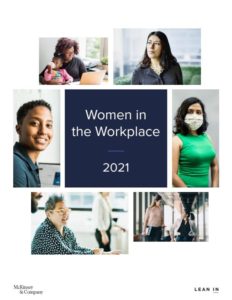This is the seventh year of Women in the Workplace, the largest study of women in corporate America. This effort, conducted by McKinsey in partnership with LeanIn.Org, analyzes the representation of women in corporate America, provides an overview of HR policies and programs—including HR leaders’ sentiment on the most effective diversity, equity, and inclusion (DEI) practices—and explores the intersectional experiences of different groups of women at work. The data set this year reflects contributions from 423 participating organizations employing 12 million people and more than 65,000 people surveyed on their workplace experiences; in-depth interviews were also conducted with women of diverse identities, including women of color, LGBTQ+ women, and women with disabilities.
The state of women hangs in the balance
A year and a half into the COVID-19 pandemic, women have made important gains in representation, and especially in senior leadership. But the pandemic continues to take a toll. Women are now significantly more burned out—and increasingly more so than men.
Despite this added stress and exhaustion, women are rising to the moment as stronger leaders and taking on the extra work that comes with this: compared with men at the same level, women are doing more to support their teams and advance diversity, equity, and inclusion efforts. They are also more likely to be allies to women of color. Yet this critical work is going unrecognized and unrewarded by most companies, and that has concerning implications. Companies risk losing the very leaders they need right now, and it’s hard to imagine organizations navigating the pandemic and building inclusive workplaces if this work isn’t truly prioritized.
There is also a disconnect between companies’ growing commitment to racial equity and the lack of improvement we see in the day-to-day experiences of women of color. Women of color face similar types and frequencies of microaggressions as they did two years ago—and they remain far more likely than White women to be on the receiving end of disrespectful and “othering” behavior. And while more White employees see themselves as allies to women of color, they are no more likely than last year to speak out against discrimination, mentor or sponsor women of color, or take other actions to advocate for them. This points to the critical need for businesses to equip employees at all levels to challenge bias and show up as allies.
The path forward is clear. Companies need to take bold steps to address burnout. They need to recognize and reward the women leaders who are driving progress. And they need to do the deep cultural work required to create a workplace where all women feel valued.
It’s the only time of my career that I seriously considered a less demanding job. I took another interview. I felt burned out so often. I felt caught in the middle of everyone’s emotional response to the pandemic and in between decision makers who have very, very different outlooks on how to respond. It was the first time I had to solve problems that so directly impacted people’s mental and physical health. It was the hardest working year of my life.
Straight White woman, senior vice president
More: The rest of this article summarizes the main findings from the 2021 Women in the Workplace report (and for an even deeper look, visit our blog to read a behind-the-scenes chat with one of the report’s coauthors).
